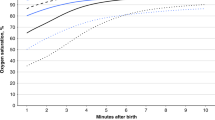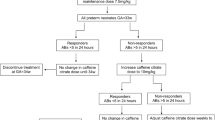Abstract
Background
Spontaneous breathing during and after delayed cord clamping (DCC) stabilizes cardiopulmonary transition at birth. Caffeine stimulates breathing and decreases apnea in premature newborns. We evaluated the pharmacokinetics and physiological effects of early caffeine administration-direct injection into the umbilical vein (UV) during DCC or administered through a UV catheter (UVC) after delivery.
Methods
Eighteen extremely premature lambs (125–127d, term gestation 145d) were exteriorized and instrumented. Lambs received caffeine-citrate at high (40 mg/kg) or standard-dose (20 mg/kg) via direct UV (DUV) injection during DCC, or via the UVC.
Results
Mean peak plasma caffeine concentrations were lower with high-dose DUV compared to UVC (18 ± 4.3 vs. 46 ± 12 mg/L, p < 0.05). With standard-dose caffeine, mean peak plasma levels were 7.48 ± 2.6 with DUV and 28.73 ± 9.4 mg/L with UVC. The volume of distribution was higher in the DUV group compared to UVC (2.5 ± 1.0 vs. 0.69 ± 0.15 L/kg) with an estimated 39 ± 18% entering the maternal circulation. Maternal peak concentrations were 0.79 ± 0.71 and 1.43 ± 0.74 mg/L with standard and high-dose DUV, respectively.
Conclusions
Caffeine injected directly into the UV during DCC is feasible but achieves lower concentrations due to high volume of distribution including maternal circulation. Further trials evaluating DUV caffeine injection should use higher caffeine doses.
Impact
-
Respiratory stimulation with early caffeine may reduce the need for intubation in preterm infants.
-
In the preterm lambs, caffeine injection directly into the umbilical vein during delayed cord clamping is feasible.
-
Plasma caffeine concentrations are less than half when administered directly into the umbilical vein during delayed cord clamping compared to administration via an umbilical venous catheter following birth likely attributed to a larger volume of distribution or injection site leak.
-
There were no significant hemodynamic alterations following caffeine injection.
This is a preview of subscription content, access via your institution
Access options
Subscribe to this journal
Receive 14 print issues and online access
$259.00 per year
only $18.50 per issue
Buy this article
- Purchase on Springer Link
- Instant access to full article PDF
Prices may be subject to local taxes which are calculated during checkout

Similar content being viewed by others
Data availability
The datasets generated during and/or analysed during the current study are available from the corresponding author on reasonable request.
References
UNICEF, W., World Bank, UN-DESA Population Division. Levels and Trends in Child Mortality Report 2019, http://www.unicef.org/reports/levels-and-trends-child-mortality-report-2019 (2019).
Parker, J. C., Hernandez, L. A. & Peevy, K. J. Mechanisms of ventilator-induced lung injury. Crit. Care Med. 21, 131–143 (1993).
Keszler, M. & Sant’Anna, G. Mechanical ventilation and bronchopulmonary dysplasia. Clin. Perinatol. 42, 781–796 (2015).
Clark, R. H., Bloom, B. T., Spitzer, A. R. & Gerstmann, D. R. Reported medication use in the neonatal intensive care unit: data from a large national data set. Pediatrics 117, 1979–1987 (2006).
Schmidt, B. et al. Caffeine therapy for apnea of prematurity. N. Engl. J. Med. 354, 2112–2121 (2006).
Kraaijenga, J. V., Hutten, G. J., de Jongh, F. H. & van Kaam, A. H. The effect of caffeine on diaphragmatic activity and tidal volume in preterm infants. J. Pediatr. 167, 70–75 (2015).
Andersson, O. et al. Effect of delayed cord clamping on neurodevelopment at 4 years of age: a randomized clinical trial. JAMA Pediatr. 169, 631–638 (2015).
Katheria, A. C., Brown, M. K., Rich, W. & Arnell, K. Providing a placental transfusion in newborns who need resuscitation. Front. Pediatr. 5, 1 (2017).
Katheria, A. et al. A randomized clinical trial of umbilical cord milking vs delayed cord clamping in preterm infants: neurodevelopmental outcomes at 22-26 months of corrected age. J. Pediatr. 194, 76–80 (2018).
Blank, D. A. et al. Baby-directed umbilical cord clamping: a feasibility study. Resuscitation 131, 1–7 (2018).
Fulton, C., Stoll, K. & Thordarson, D. Bedside resuscitation of newborns with an intact umbilical cord: experiences of midwives from British Columbia. Midwifery 34, 42–46 (2016).
Zhang, Y., Mehrotra, N., Budha, N. R., Christensen, M. L. & Meibohm, B. A tandem mass spectrometry assay for the simultaneous determination of acetaminophen, caffeine, phenytoin, ranitidine, and theophylline in small volume pediatric plasma specimens. Clin. Chim. Acta 398, 105–112 (2008).
Comer, A. M., Perry, C. M. & Figgitt, D. P. Caffeine citrate: a review of its use in apnoea of prematurity. Paediatr. Drugs 3, 61–79 (2001).
Aranda, J. V., Gorman, W., Bergsteinsson, H. & Gunn, T. Efficacy of caffeine in treatment of apnea in the low-birth-weight infant. J. Pediatr. 90, 467–472 (1977).
Turmen, T., Davis, J. & Aranda, J. V. Relationship of dose and plasma concentrations of caffeine and ventilation in neonatal apnea. Semin Perinatol. 5, 326–331 (1981).
Natarajan, G., Botica, M. L., Thomas, R. & Aranda, J. V. Therapeutic drug monitoring for caffeine in preterm neonates: an unnecessary exercise? Pediatrics 119, 936–940 (2007).
Lee, T. C., Charles, B., Steer, P., Flenady, V. & Shearman, A. Population pharmacokinetics of intravenous caffeine in neonates with apnea of prematurity. Clin. Pharm. Ther. 61, 628–640 (1997).
Ulanovsky, I., Haleluya, N. S., Blazer, S. & Weissman, A. The effects of caffeine on heart rate variability in newborns with apnea of prematurity. J. Perinatol. 34, 620–623 (2014).
Katheria, A. C. et al. A pilot randomized controlled trial of early versus routine caffeine in extremely premature infants. Am. J. Perinatol. 32, 879–886 (2015).
Dekker, J. et al. Caffeine to improve breathing effort of preterm infants at birth: a randomized controlled trial. Pediatr. Res. 82, 290–296 (2017).
Lodha, A. et al. Association of early caffeine administration and neonatal outcomes in very preterm neonates. JAMA Pediatr. 169, 33–38 (2015).
Patel, R. M., Leong, T., Carlton, D. P. & Vyas-Read, S. Early caffeine therapy and clinical outcomes in extremely preterm infants. J. Perinatol. 33, 134–140 (2013).
Lodha, A. et al. Early caffeine administration and neurodevelopmental outcomes in preterm infants. Pediatrics 143, e20181348 (2019).
Soloveychik, V., Bin-Nun, A., Ionchev, A., Sriram, S. & Meadow, W. Acute hemodynamic effects of caffeine administration in premature infants. J. Perinatol. 29, 205–208 (2009).
Binder-Heschl, C. et al. Haemodynamic effects of prenatal caffeine on the cardiovascular transition in ventilated preterm lambs. PLoS One 13, e0200572 (2018).
Acknowledgements
This work was made possible thanks to the UC Davis Department of Pediatrics Resident and Fellow Grant.
Funding
NIH/NICHD 5R01HD072929-10 (SL).
Author information
Authors and Affiliations
Contributions
L.Z., S.L., and P.V. designed the study. H.K., A.L., H.J., M.H.; E.G. and D.K. contributed to data acquisition. Data analysis and interpretation was performed by L.Z., H.K., S.L. and P.V.; L.Z. wrote the first draft of the manuscript. A.L., E.G., D.S., S.L. and P.V. critically revised the manuscript for important intellectual content. All the authors have approved the approved the final version of the manuscript submitted for publication and agree to be accountable for all aspects of the work in ensuring that questions related to the accuracy or integrity of any part of the work are appropriately investigated and resolved. All persons designated as authors qualify for authorship, and all those who qualify for authorship are listed.
Corresponding author
Ethics declarations
Competing interests
The authors declare no competing interests.
Additional information
Publisher’s note Springer Nature remains neutral with regard to jurisdictional claims in published maps and institutional affiliations.
Rights and permissions
Springer Nature or its licensor (e.g. a society or other partner) holds exclusive rights to this article under a publishing agreement with the author(s) or other rightsholder(s); author self-archiving of the accepted manuscript version of this article is solely governed by the terms of such publishing agreement and applicable law.
About this article
Cite this article
Zeinali, L., Giusto, E., Knych, H. et al. Caffeine pharmacokinetics following umbilical vein injection during delayed cord clamping in preterm lambs. Pediatr Res (2024). https://doi.org/10.1038/s41390-024-03117-3
Received:
Revised:
Accepted:
Published:
DOI: https://doi.org/10.1038/s41390-024-03117-3



